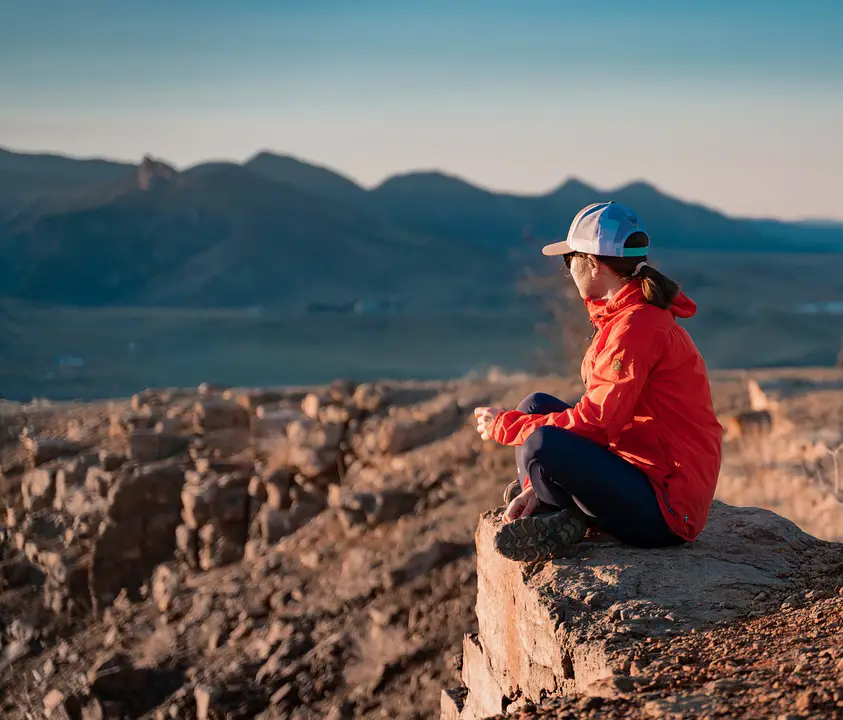Nothing’s better than getting out on the open trail and taking in the sights nature has to offer!
Hiking is one of the absolute best ways to do this, but you need to be prepared and have the right gear – and a key component of this is having the right hiking boots.
Having the right pair of hiking boots is going to make your hikes more enjoyable and safe, and luckily you don’t need to break the bank to get a great pair.
That’s exactly why we put together our top picks for the best women’s hiking boots under $100.
Read on for the best hiking boots under $100 for women available on the market today, along with what you should look for when making your selection.
The Best Women’s Hiking Boots Under $100 – Quick Reference
| Best Overall Women’s Hiking Boots Under $100 | Columbia Women’s Newton Ridge Plus Waterproof Amped |
| Best Mid Cut Women’s Hiking Boots Under $100 | Timberland White Ledge Mid Waterproof |
| Best Waterproof Women’s Hiking Boots Under $100 | Merrell Moab 2 Mid Waterproof |
| Most Stylish Women’s Hiking Boots Under $100 | Foxelli Women’s Waterproof |
| Best Ready-To-Wear Women’s Hiking Boots Under $100 | Columbia Redmond V2 Mid Waterproof |
| Best Support Women’s Hiking Boots Under $100 | KEEN Targhee II Mid Waterproof |
| Best Women’s Hiking Shoes Under $100 | Merrell Moab 2 Vent |
The Best Hiking Boots Under $100 For Women
Columbia Women’s Newton Ridge Plus Waterproof Amped Hiking Boots

The Columbia Women’s Newton Ridge Plus Waterproof Amped Hiking Boot is an excellent lightweight, water-resistant boot that is also absurdly comfortable.
The cushioning and advanced traction rubber sole makes these boots excel at handling steep inclines and rough terrain.
The lace-up enclosures allow for a secure, tight fit and the inner materials are breathable and supple.
These boots are great all-weather performers and come in a variety of colors to suit any style or preference.
Why We Like It:
-Waterproof makes these boots great for year-round use
-Sole offers excellent grip and traction
-Extremely comfortable and breathable
-Lightweight while still offering all the support you’ll need
Timberland Women’s White Ledge Mid Waterproof Ankle Hiking Boots

Timberland’s built a longstanding reputation for their quality boots, and that’s absolutely apparent in the White Ledge Mid Waterproof Ankle Boot.
They’re casual enough for everyday use, but are also excellent for hiking and outdoor work.
The large toe box provides comfort where it’s needed, and the fact they’re waterproof and durable means you’ll be using them in all kinds of hikes – and other situations – for a long time.
Why We Like It:
-Premium waterproof materials hold up to moisture and are highly durable
-Rustproof lace hardware makes sure your boots stay on tight
-Very comfortable materials
-Multidirectional lugs on the soles provide plenty of traction and grip
Merrell Moab 2 Women’s Mid Waterproof Hiking Boots

The Merrell Moab 2 Mid Waterproof Hiking Boot is a favorite among men and women due to it’s excellent waterproof qualities thanks to a waterproof membrane in the boot.
They feature a Vibram TC5+ outsole, which offers outstanding traction on almost any type of terrain.
These boots have plenty of underfoot cushioning, insoles with great arch support, and are breathable, keeping your feet dry in any situation.
The boot also features an EVA midsole which is great at shock absorption.
Why We Like It:
-Waterproof membrane and breathable materials keep your feet dry in wet conditions
-Kinetic Fit Base EVA footbed provides much-needed heel support
-Vibram TC5+ outsole offers great traction on plenty of terrain types
-Full-grain leather upper is highly durable
Foxelli Women’s Waterproof Hiking Boots

The Foxelli Waterproof hiking boot is an excellent option if you’re looking to spend under $100 on a pair of lightweight and waterproof women’s hiking boots that pack a lot of style in them.
They’re rugged and comfortable and are constructed from waterproof and breathable materials.
The durable construction provides toe caps and rubber bumpers for safety, while the lugged rubber outsole offers traction no matter where you’ll be hiking.
They also offer great arch and ankle support, which are key features in any hiking boot.
Why We Like It:
-Waterproof and durable construction means you can use them anywhere
-Outsole provides great traction wherever you’re hiking
-Shock-absorbent midsole provides great underfoot comfort and support
-Ankle height design provides critical support where it’s needed
Columbia Women’s Redmond V2 Waterproof Hiking Boots

Columbia continues to deliver on it’s reputation for quality gear with the Columbia Redmond V2 Mid Waterproof Hiking Boot.
These boots are great for all seasons, with a grippy outsole and breathable fabrics incorporated throughout.
The reinforced toe and heel construction makes sure these boots stand up to whatever you put them through, and the seam-sealed membrane bootie construction makes sure water stays off your feet.
Why We Like It:
-Waterproof features and grippy outsole make these great performers for all seasons and terrains
-No break-in period needed – these boots are ready to hike on right out of the box
-Excellent mid-sole support and comfort
-Durable and high-quality materials means these boots are made to last
KEEN Targhee II Women’s Mid Waterproof Hiking Boots

KEEN’s Targhee II Mid Waterproof Hiking Boot is a great all-around performer, offering a waterproof and breathable membrane, durable materials, and a high-grip outsole.
The mid-high cut of these boots offers great ankle support and balance, and the contoured heel adds extra stability where it’s most needed.
These boots take waterproofing seriously, combining a membrane along with an all-leather and water-repellant upper to make sure your feet stay absolutely dry on the trail.
They’re no slacker in the support category either, offering an external support shank, which is a nice feature not often found in the budget hiking boot category.
Why We Like It:
-Excellent waterproof materials and membrane keep moisture out
-Removable dual-density EVA footbeds
-Mid-height ankle cut, support shank, and contoured heel offer excellent support
-Large toe cap offers extra protection
-Lots of features for a low price point
Merrell Moab 2 Vent Women’s Hiking Shoes

If you’re more of a hiking shoe person, our best bet for under $100 is the Merrell Women’s Moab 2 Vent Hiking Shoe.
They’re great at combining stability, comfort, and ventilation.
Targeted air cushioning in the heel provides the comfort you’ll need, and they’re great at being breathable while also keeping debris out of them.
For safety and stability, they offer a protective rubber toe cap and feature the Vibram TC5+ soles also found on the Merrell Moab 2 Women’s Mid Waterproof Hiking Boots for an added value.
If you’re environmentally conscious – and what hiker isn’t – these hiking shoes are made from recyclable materials, so you can feel good about investing in a sustainable product.
Why We Like It:
-Great safety and stability features
-Breathable materials keep your feet comfortable on long hikes
-Durable and environmentally-friendly materials
-Comes in over 15 color options

How To Choose The Best Hiking Boots Under $100 For Women
There are so many boot options and styles available to hikers today that it can be disorienting at times.
No matter your situation, here’s what to consider to make sure you get the best pair of women’s hiking boots under $100 for your needs.
Make Sure You’ve Got Adequate Support
Support is key in any boot, and especially for hiking. Make sure your boots support your ankles and prevent them from twisting while you move.
Also look for thicker outsoles that offer lug patterns that will help you to get grip and traction on a variety of surfaces.
Lastly, opt for a pair of hiking boots that offer a shank in the midsole, giving you extra support for rough terrain.
Pay Attention To The Materials
When possible, opt for materials that offer durability and breathability. Most hiking boots will have this naturally, as they are designed to stand up to the demands of the trail.
Waterproofing will also be a key consideration if you’ll be hiking in wet conditions. Look for hiking boots that offer waterproof membranes along with additional water-resistant outer materials.
Comfort Is Paramount
Keeping comfort in mind is critically important when choosing your hiking boots, as you’ll be spending a lot of time in them.
Pay attention that your toes have enough room to wiggle around in the boot and that the sides of your feet and heel are snug.
Note that while a stiffer midsole may seem less comfortable at first, you’ll be thankful for the support when it comes to hiking on rough terrain filled with rocks or tree roots.
Think About Your Activities
Will you be doing basic hikes? Hiking steep terrain? Maybe even some mountaineering, ice climbing, or crossing water?
All of these will impact what hiking boots under $100 are best for you. Consider the boots’ compatibility with crampons or gaiters depending on your needs.
Know The Trail You’re Hiking
It’s always a great idea to research a new trail before your first time hiking it to know the type of terrain and any potential obstacles you may be up against.
This will also allow you to choose the best boot features for your situation.
Consider Your Environment
If you’ll be using your boots for both hiking and work, think about the most common situations you’ll find yourself in.
Is water or moisture a concern? Best to go with waterproof boots here.
Same goes for ankle support and safety features – the value of these really depends on your use case, but you generally can’t go wrong with more support versus less.
Keep The Weather Conditions In Mind
Some boots are rated for specific seasons, while others are all-weather.
Pay attention to this (as well as the boot’s waterproof rating) when making your selection.
Factor In The Weight
One big varying factor in hiking boots, especially boots under $100, is the weight factor.
Think about what types and lengths of hiking you’ll be doing, your overall fitness level, and your stamina when selecting your hiking boots, as weight will make a big difference over longer hikes.

How To Get A Great-Fitting Pair Of Women’s Hiking Boots For Under $100
Hiking boots should fit snugly around the sides and heel of your foot, provide sturdy ankle support, and leave an inch in the front for your toes. You should always try on hiking boots at the end of the day to consider foot swelling, and wear your usual pair of hiking socks.
Here are some key points to look for when you’re thinking about how hiking boots should fit:
- You should have at least an inch of toe room in the front, and enough room for your toes to wiggle around.
- Up to a quarter-inch heel lift is okay at first – after your boots are broken in this heel room should resolve itself, otherwise you can use a heel grip to close the gap.
- If you ever start to feel like your foot is falling asleep (aka “pins and needles”), this is a sign that your boots are too tight, and it’s time to move up a size or try thinner socks if you’ve already purchased the boots and can’t return them.
- If you’re flat-footed, you’ll need to consider a half-size up in hiking boot to make room for orthopedic insoles to support your arches.
There are many additional factors to consider as you fit yourself for a new pair of hiking boots under $100 – read on for an in-depth analysis and what to look for.
Check out our guides to How Should Hiking Boots Fit and How Much Toe Room Is Needed In Hiking Boots for in-depth explanations.
Different Types Of Women’s Hiking Boots – And How They Fit Differently
There are many types of hiking boots available, and all the options can be overwhelming. Make sure to pick the right type of hiking boot for your intended use.
Let’s break down the most common types of hiking boots you’ll encounter while looking for your next pair.
Hiking Shoes
These low-cut models offer flexible midsoles and are best used for day hiking.
Day Hiking Boots
Day hiking boots come in mid and high-cut options and are best for day hiking or shorter backpacking trips with lighter loads.
They’re easy to break in and have decent flex, but they don’t offer as much support as proper backpacking boots.
Backpacking Boots
You’ll want a pair of proper backpacking boots if you’re doing trips spanning several days, or going deep into the wilderness.
These boots usually come in high cut only, wrapping around the ankle to give extra support.
Backpacking boots are durable and offer stiffer midsoles than lighter boot options, and have the support you’ll need both off and on the trail.
Waterproof vs Non-Waterproof
Hiking boots come in both waterproof and non-waterproof options. Waterproof boots are great at resisting moisture, but are less breathable.
The choice is up to you, but be sure to select the right option for your needs.
If you’ll be hiking in snow, crossing streams or creeks, or otherwise getting outside in wet conditions, you’ll absolutely want to opt for a waterproof hiking boot.
If you don’t plan on hiking in these conditions, you can go non-waterproof.
Minimalist, Barefoot, and Zero-Drop Hiking Shoes
These shoes are intended to minimize padding and support to allow you to get as close as possible to a barefoot experience while still providing some protection and grip.
Choosing this type of hiking shoe is largely up to personal preference, and you’ll need to try them on to see if a barefoot-feel is right for you.

What To Know About Components Of Women’s Hiking Boots Under $100
Hiking Boot Uppers
What material your boot is made from determines critical factors like weight, durability, water resistance, and breathability. Read on to see what materials you’ll come across when shopping for hiking boots.
Full Grain Leather
Full-grain leather is durable and resists abrasions, and also offers great water resistance. You’ll typically find full-grain leather used in backpacking boots.
Full-grain leather is not as breathable or as light as split-grain leather or nylon. Also, full-grain leather boots take longer to break in.
Split Grain Leather
Split-grain leather is usually combined with nylon to offer a breathable and lightweight hiking boot.
Split-grain leather will result in a lower cost boot, but also is less resistant to water and scuffs.
Nubuck Leather
Nubuck leather is simply full-grain leather that has been buffed to look like suede.
Nubuck is durable and resists abrasions and moisture, and is flexible too.
Expect nubuck leather hiking boots to take longer to break in.
Synthetics
Nylon, polyester, and synthetic leather are all materials used in many of today’s hiking boots.
Compared to leather, synthetics cost less, break in more quickly, are more lightweight, and dry faster.
The trade-off with synthetics is that they can wear down faster than leather.
Waterproof Membranes
Waterproof hiking boots feature breathable and waterproof membranes (like Gore-Tex and eVent) to keep water off your feet.
You’ll be sacrificing breathability with waterproof hiking boots, which can lead to sweaty feet in warmer hiking conditions, but waterproofing is a must if you’ll be doing longer hikes in wet conditions.
Vegan Materials
Vegan materials are made without any animal ingredients. Modern vegan hiking boots are beefy enough to provide plenty of protection and come in waterproof options.
Insulation
Some hiking boots offer added synthetic insulation to provide additional warmth, which is a plus if you’ll be hiking in snow or colder conditions.
Hiking Boot Midsoles
The boot’s midsole provides cushioning for the foot and helps to absorb shocks.
The midsole provides stiffness to the boot, which can provide better comfort and stability when hiking on rocky and uneven terrain.
Most midsoles are made from either EVA (ethylene vinyl acetate) or polyurethane.
EVA Midsoles
EVA is lighter, less expensive, and provides more cushioning than polyurethane, and comes in different densities to provide more support in needed areas within the boot.
Polyurethane Midsoles
Polyurethane is more durable and firmer than EVA, making it a common choice in backpacking and mountaineering boots.
Hiking Boot Internal Support
Shanks
Shanks are inserts between 3-5mm thick that are placed between the hiking boot’s outsole and midsole to provide stiffness and load-bearing.
Shanks vary in length, ranging from covering half the boot or all the way to the entire length of the boot.
Plates
Plates are semi-flexible, thin inserts that may be found in boots either alone or in conjunction with shanks.
Plates allow additional foot protection against uneven terrain like tree roots or rocks.
Hiking Boot Outsoles
Rubber is the main material used on nearly all outsoles of hiking boots. Sometimes, additives like carbon are included to increase the rubber’s hardness.
This hardness is great for durability, but can get slick on wet terrain, especially off trail.
Lug Pattern Outsoles
Lugs are bumps on the outsole designed to provide traction. Mountaineering and backpacking boots feature deeper and thicker lugs to increase grip.
Wide-spaced lugs help to shed mud and offer good traction.
Heel Brake Section
The heel brake section of a hiking boot’s outsole is specially designed to increase heel grip to reduce your chances of sliding while hiking steep declines.
Opt for a hiking boot with a heel brake on the outsole if you plan on hiking steep terrain.
Crampon Compatibility
Crampons are hiking boot attachments that improve mobility on snow or ice, typically in ice climbing.
If that’s something you’ll be doing, be sure that you pick a boot that offers compatibility with crampons.

Tips For Enjoying Your New Women’s Hiking Boots Under $100
Maintain A Slow To Moderate Pace
Since most steel toe hiking boots weigh more than standard hiking boots, maintaining your pace will allow you to preserve your energy for longer distances and periods of time.
Wear Comfortable Socks
Always wear hiking socks, even if using a non-hiking-specific pair of boots.
Consider a pair of neoprene hiking socks if you’ll be going through water or when hiking through snow.
Use Walking Poles
Walking poles help provide extra support by distributing weight through the poles and keeping it off your legs.
Avoid Carrying Extra Weight
Minimize your load as much as you can, and if you must use a backpack, opt for a lightweight one rather than a bulky pack. This will help with load distribution during your hike.
Stay In Shape
Don’t skip leg day, especially if you’re an avid hiker! Staying in shape and doing leg exercises goes a long way when determining the length and enjoyability of your hiking trips.
Best Hiking Boots For Women Under $100 – Frequently Asked Questions
What’s The Difference Between Women’s And Men’s Hiking Boots?
The difference between women’s hiking boots and men’s hiking boots mostly comes down to the shape and size of the boot.
Women’s feet are narrower and smaller while men’s feet tend to run larger and wider, – the boot designs and sole patterns reflect this.
The only other differences are cosmetic beyond the size and sole patterns such as designs and color options.
What’s The Difference Between Hiking Boots And Hiking Shoes?
The key difference between hiking boots and hiking shoes is the cut, with most hiking shoes being low cut and offering no ankle support.
Beyond that, hiking shoes are typically softer and more flexible than hiking boots, aren’t as tricky to fit, and don’t need breaking in.
Hiking shoes are a good choice for dry weather and gentler terrain and place an emphasis on breathability.
We recommend hiking shoes over hiking boots only if you’ll be hiking eclusively in spring or summer and mainly in dry conditions.
Should I Buy Hiking Boots One Size Bigger?
It’s common advice among hikers to buy hiking boots one size larger than your average shoe size to accommodate for the swelling of your feet and to provide ample toe room.
Instead, we suggest trying on hiking boots at the end of the day (when your feet are already swollen) to get a better feel for the size of hiking boot you’ll need.
Feel free to move up a half-size based off of how the boot feels, and always be sure you have enough toe room.
How Should My Hiking Boots Feel?
Hiking boots should have enough room for your toes to wiggle up and down and side to side, should support your ankle, and should have a quarter inch or less of heel action.
You should be able to fit one finger snugly in between your heel and the back of the boot when your toes are touching the front of the boot.
You should also feel the boot hugging the sides of your foot without pinching or constricting.
Do I Need Insoles For Hiking Boots?
The need for hiking boot insoles largely comes down to personal preference and if you’re trying to dial in the fit of your boots.
If you have conditions such as structural misalignment, plantar fasciitis, or supination/over-pronation issues, hiking boot insoles can be of great help to you.
How Do I Know If My Hiking Boots Are Too Big?
Your hiking boots are too big if:
- Your heel is slipping
- Your foot can move side-to-side in the boot
- Your ankle feels wobbly within the boot
To combat this, you can use insoles or experiment with thicker hiking socks to decrease movement and improve stability within the boot.
Should I Wear Special Socks To Try On Hiking Boots?
We recommend wearing the hiking socks you usually use when trying on hiking boots, which will give you a more accurate feel.
If you use inserts, insoles, or orthopedic products, bring those along with you too.
Should I Buy Leather Or Synthetic Hiking Boots?
This is up to your budget and personal preference. Leather costs more and takes longer to break in, but is more durable over time and can stretch to fit your feet, resulting in a great fit.
If you’re on a budget, synthetic hiking boots work excellently as well.
Do Hiking Boots Fit Differently Than Regular Shoes?
Most regular shoes are designed for comfort and casual use. You should expect hiking boots to leave more room in front of your toes to be tighter on the sides and heel compared to regular shoes.
How Long Do Hiking Boots Last?
Most hiking boots last between 500-900 miles depending on their quality, frequency of use, and the terrain you typically hike on.
When Should I Replace My Hiking Boots?
Generally you should replace your hiking boots if they are not comfortable to wear anymore, have lost their structure, or if the sole of the boot is not properly attached to the boot’s upper.
How Do I Avoid Blisters While Hiking?
Blisters occur when your feet continue to rub against something while you hike like a poor-fitting boot or a bunched up sock – any source of constant friction.
The best way to prevent blisters is to make sure your socks and boots fit well. Pay attention to where blisters are forming, and that will let you know where you need to focus on reducing friction (or getting more room) in your boot.
What Socks Are Best Used With Hiking Boots?
We recommend polyester blend hiking socks as they perform better against moisture than cotton socks and also work to reduce friction, cutting down on the chance of blisters.
Be sure that your socks are not too loose, as they can bunch up and cause blisters. Also, be careful that they’re not too small either, as that can cause extra constriction and discomfort on your feet.
If you’ll be hiking in wet or snowy conditions, consider a pair of neoprene hiking socks for an added layer of protection.
How Do I Maintain My Hiking Boots?
Keeping your hiking boots clean will extend the use you get out of them.
Always read through the manufacturer’s care instructions, but as a general rule leather should only be cleaned with water.
Make sure to completely air dry your boots after cleaning them, and apply waterproofing treatments regularly if your boots feature any type of waterproof materials.
Wrapping Up The Best Hiking Boots Under $100 For Women
Having the right pair of hiking boots plays a huge role in the enjoyability of your trek.
Keeping the durability, comfort, fit, and quality of your boots are all things you’ll want to keep top of mind as you choose which pair of $100 hiking boots are best for you.
Let us know in the comments below on what pair you picked, along with any questions! We’d love to know what you chose.
Thinking about hiking with the kids, or going winter hiking? Check out our guide to the best all-terrain hiking strollers and the best hiking gloves while you’re here.
If you’ve got flat feet, check out our guide to the best hiking boots for flat feet as well.

